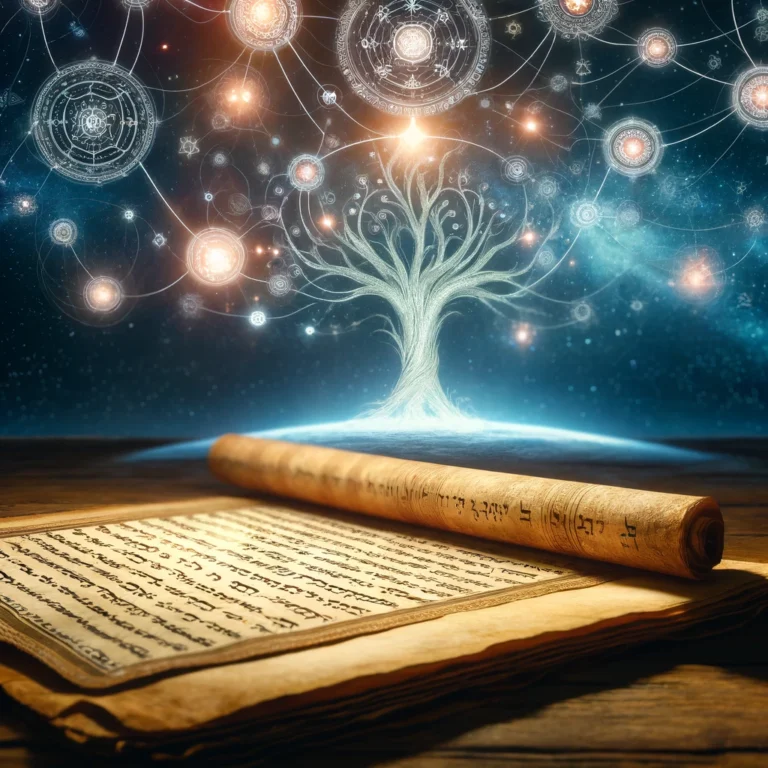What is Da’at and why is it sometimes left out of the Ten Sefirot?
The Sefirah of Da’at (lit: “knowledge”) occupies a unique and sometimes controversial place in the structure of the Sefirot. In certain configurations, such as those that include Keter, Da’at is omitted. In others, where Keter is considered too lofty and concealed, Da’at appears in its place, serving as the practical manifestation of superconscious will within the intellectual realm. In very few places we find that both are together.
The Arizal explains in Etz Chaim that this is not an independent Sefirah like Chochmah or Binah, but a composite, born from their union, allowing their light to flow into the emotional Sefirot below. It is this union, which is illustrated by the “knowing” of Adam toward his wife that happen on a mental level.
Yet, this quasi-Sephira is the foundation of all spiritual work as we will soon see.
This article is part of the Tree if Life series.
- Sephira of Keter
- Sephira of Chokhmah
- Sephira of Binah
- Sephira of Da’at
- Sephira of Chessed
- Sephira of Gevurah
- Sephira of Tiferet
- Sephira of Netzach
- Sephira of Hod
- Sephira of Yesod
- Sephira of Malkhut
The Zohar refers to it as the key that “includes all other Sefirot.” It is the internal consciousness that binds together the upper and lower worlds, mind and heart, theory and lived reality. Without Da’at, knowledge remains abstract and detached.
But with Da’at, wisdom becomes part of one’s being, shaping the soul’s orientation toward Hashem and anchoring Divine awareness within daily life.
So, what is it really and how can we apply it to daily life?

Da’at as the Channel Between the Mind and the Heart
In the figure above, the reader can see that Da’at occupies the boundary between the mind and emotions, because it is called in Etz Chaim the “soul of [the lower 7] emotions”. In modern terms this would be considered the state of base awareness (or mindfulness), where one is in control of himself and can actually draw down the light of the intellect to sweeten his emotions.
The thing is it actually possesses at least 8 different aspects as follows:
- Knowledge – what you can readily explain
- Awareness – being in the moment with attention
- Connection – the capacity to be united with an idea
- Lower will – conscious desire for something (higher will is Keter)
- Recognition – assessing an idea for what it is
- Judgment – evaluating ideas, holding opposites
- Self-control – being able to sweeten and rule over one’s emotions
- Sympathy and compassion – only acquired by those that feel another’s pain
I don’t think we need to elaborate on the list above, as it is pretty much self-evident.
If you stop now and put your attention to your breathing, you will see that now you’ve entered a state of awareness, which is an aspect of Da’at. Rebbe Nachman of Breslov also explains in Likutey Moharan the sages’ maxim in the Talmud that “one shouldn’t have compassion upon those who don’t possess Da’at.
The reason is very simple: since that person lacks sympathy and compassion, then by the measure for measure principle, we should also not have sympathy and compassion upon him (I believe he’s speaking in levels, not as an absolute, though. Someone who’s expected to have a higher level of awareness should be given less of a “pass”).
This, therefore, is the vital channel that allows the light of Chochmah and Binah to be internalized by the emotional faculties. Ultimately, all the wisdom in the world is not used to the fullest if it cannot come down to shine upon a person’s soul because it stays as an abstract exercise which leads nowhere. (and even the most practical of skills should at the very least make one more humble).
It is what allows learning to translate into fear of Heaven, Torah study to affect character, and Divine concepts to descend into the heart. This explains why the verse says, “You shall know (v’yadata) today and return it to your heart” (Devarim 4:39), because Da’at is the bridge between the two.
The Two Levels of Da’at: Elyon and Tachton
In Eitz Chaim, the Arizal distinguishes between two aspects of Da’at Elyon (Higher Da’at) and Da’at Tachton (Lower Da’at). The first functions within the upper intellectual triad, serving as the unifying principle between Chochmah and Binah. It draws their energies together in harmony and maintains a balanced flow between wisdom and understanding. This upper Da’at is related to supernal clarity and Divine attachment, operating on a level of consciousness that is beyond emotional fluctuation.
Indeed, one of my first recommendations to private students is to practice the silent meditation, in which one tries to quieten the monkey mind. This is incredibly powerful to put a person in a state of choice and trance. The more you practice, the more powerful it gets and ultimately it can awaken intuition, greater empathy, sensitivity to energy and other psychic skills.
Da’at Tachton, by contrast, descends into the realm of the lower seven Sefirot and serves as the conscious transmission of those higher lights into emotional reality. It takes the clarity forged above and applies it to the structure of the soul below. This aspect of Da’at is essential for spiritual integration. Without it, the emotional Sefirot of Chesed, Gevurah, Tiferet, and so on remain disconnected from their intellectual source.
With it, they become refined and aligned with the Divine order. As the sages teach in Vayikra Rabba “If you have acquired Da’at, what do you lack? If you lack Da’at, what do you have?” for this Sephira alone carries awareness from mind to being.
Essentially, it is a pre-requisite for all forms of elevation and transcendence, because without it, there’s no one to experience the experience.

Da’at as a Vessel for Attachment and Consciousness
As we mentioned before, the Torah’s first use of the root of Da’at is in the verse, “And Adam knew Eve his wife” (Bereishit 4:1). Rashi explains this as an expression of intimate union. The Mekubalim expand on this, seeing in the word Da’at the concept of hitkashrut (i.e. deep attachment), not only intellectual but existential.
One good exercise for this is to try to feel an object as you softly gaze into it. You could go even further and imagine yourself as if you are the object itself.
This idea has practical implications. The degree to which a person lives with Da’at, meaning awareness of Hashem’s presence and guidance determines the level of Divine clarity they experience in their personal path. The Zohar relates that the righteous draw down clear hashgachah into their lives because their Da’at is constantly focused on the root of all existence. This is also the mystery of Devekut, to be attached to God at all times and it refines one’s perception.
It enables a person to read reality not as random events but as messages, patterns, and opportunities for connection with the Creator.
The Dangers of False Da’at and Misguided Certainty
However, the power of Da’at can be used either in holiness or distorted in impurity.
The Zohar warns that when Da’at is hijacked by ego or misdirected intellect, it can fall into the domain of the Sitra Achra and become Da’at shelo b’kedushah knowledge outside of holiness. In this form, Da’at breeds arrogance, false certainty, and separation from God. What was meant to unite becomes a source of disconnection.
One of the greatest danger in spiritual life is a sense of knowing that lacks humility.
A person may learn deeply and speak in refined terms, but if their Da’at does not lead to surrender and awe, it becomes a stumbling block and the Torah can become a “sam mavet” (potion of death). True Da’at produces humility and yirat shamayim (fear of Heaven). It does not inflate the ego but nullifies it. It brings the person closer to the reality of Hashem, not just intellectually but in every aspect of life.

Just as the brain sends signals to coordinate the body’s movements, Da’at channels intellectual awareness into the heart, keeping emotional responses aligned with truth. This makes it crucial for personal integrity. Without this Sephira, a person may understand something is wrong, yet still act against it. With it, the mind and emotions are in harmony, leading to consistent spiritual behavior. In business, this is also vital for proper decision making and not letting the emotions take control over us.
This means that true bechirah (choice) is not about reacting or choosing impulsively, but about choosing with awareness, connection to Hashem, and understanding of consequences. The higher the level of one’s Da’at, the more real their freedom becomes.
Superficial repentance and elevation without awareness, clarity, or heartfelt connection lacks the ability to uproot sin completely.
This deep form of Teshuvah transforms a person’s identity, not just their behavior.
Conclusion: Living as a Vessel for Divine Presence
As we just saw, the Sefirah of Da’at is the hidden link that makes spiritual truth real.
It is not merely intellectual clarity or emotional depth, but the unification of both in a sustained awareness of Hashem. It teaches that knowing is not about quantity of information, but quality of connection. One who has Da’at brings Heaven into earth, drawing the light of the upper worlds into lived experience.
This means not only studying truth, but attaching to it, returning to it constantly, and allowing it to shape how we think, feel, and act. May we merit to deepen our Da’at with humility and sincerity, and through it, become firmly rooted in the light of Hashem.








